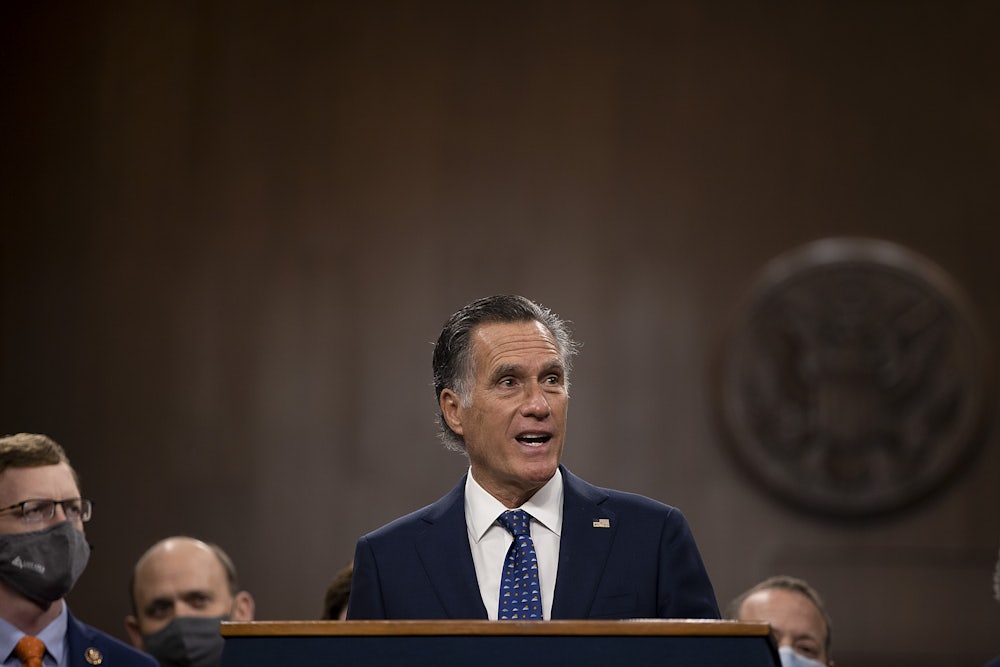On Thursday, Republican Senator Mitt Romney made a huge splash: He put forward a proposal to create what would amount to the first-ever child allowance in the United States, sending nearly all families $350 a month for children age zero to five and $250 a month up to age 17.
While Democrats have recently started to coalesce around the idea of regularly sending money to parents, it’s notable to have a Republican join them by offering his own ideas, especially one who, just eight years ago, decried the government giving away “free stuff.” His is a serious plan and should be taken seriously. That means looking hard at the details. And those details make it clear that his plan is not just about reducing poverty but also reducing the government’s responsibility to the poor. This doesn’t mean the plan is a nonstarter but that Democrats have to make clear that they stand for increasing what the state owes its most vulnerable and for an expansive vision of how the government should lift our standards of living, and not accept the austere premise that cash payments must be substituted for existing programs.
It’s important to consider the choices made when lawmakers design policy. I take Romney at his word that his first priority is supporting families and reducing poverty. By one estimate, his plan would cut child poverty by a third and by nearly 14 percent overall. But that’s not his only goal, as evidenced by the fact that some of the provisions in his plan mean it would reduce poverty less than it would without them, and less than a similar one put forward by President Biden. Romney’s own economic adviser said of the plan that “it shows it’s possible to reform, or even eliminate, existing policies and still leave American families better off,” adding, “We don’t just have to endlessly top-off the current system.” As Romney put it in 2012, “If you’re looking for free stuff you don’t have to pay for? Vote for the other guy.” It’s this ancillary motivation, to wipe out chunks of our current anti-poverty system and narrow the window of what role the government plays, that demands pushback.
Romney’s plan is a big step up from one he co-authored in 2019 to give parents $1,000 to $1,500 a year, when he became the first Republican to endorse such an idea. Now he supports sending them triple that amount. He also put forward the innovative idea of delivering this money through the Social Security Administration, which is used to sending monthly checks, rather than the Internal Revenue Service, which only does annual lump sums. There are some challenges with that approach—it could make it difficult for undocumented immigrants to claim, and it would mean getting the SSA up to speed on who is eligible—but it could be a smarter way to deliver this benefit.
But Romney also outlines ways to cover the cost of his proposal. This is certainly at least in part to make it germane to budget reconciliation, allowing it to get tacked onto Democrats’ Covid-19 relief package and made permanent. The cuts he makes to pay for it, however, are significant, both in what he cuts and the vision it puts forward. Beyond basically scrapping and converting the existing Child and Dependent Care Credit into his larger cash payment, he would also completely eliminate the Temporary Assistance for Needy Families program, or cash welfare, as well as cut Supplemental Nutrition Assistance Program eligibility and the Earned Income Tax Credit. Romney makes no indication of filling the holes that his plan would leave behind.
And even though he would send money to many struggling Americans, it would leave big holes in our safety net. TANF is admittedly a shell of its former self. After Republicans relentlessly pushed for welfare reform and Bill Clinton gave them much of what they wanted, in the mid-1990s, the program’s funding has withered without the benefit of yearly increases. The block-grant design has allowed states to use it as a slush fund for other pet projects—a $1.1 million payment to Brett Favre for appearances he never made is a particularly notorious example—with scant accountability. States have added reams and reams of red tape that keeps most poor families from getting benefits. Only about 20 percent of the funds currently put cash in poor people’s hands.
Still, it serves a purpose. It lifts 300,000 people out of poverty every year. And it’s one of the few ways that the country subsidizes childcare. Seventeen percent of TANF spending goes to childcare subsidies, an important benefit for parents trying to work.
The argument can easily be made to eliminate the program and build something better in its place—robust benefits that more easily get to the people who need them. But let’s be very clear: That’s not what Mitt Romney is doing. His goal is not rebuilding TANF but using it as a way to pay for a different project. Parents on TANF will instead receive Romney’s money—which has the benefit of coming with virtually no bureaucracy to navigate—but childless recipients won’t. And those parents will have given up TANF and other benefits for this lump sum.
TANF is not the only place Romney looks for savings. He ekes out $3.1 billion from changes to food-stamp eligibility and makes a $47 billion cut from the EITC. He also deploys some other tax changes. (He eliminates the State and Local Tax Deduction, a pet policy of some Democrats but one that is highly regressive. Good riddance.) Some have estimated that with these changes, low-income single parents could be worse off under Romney’s plan. Romney could, of course, have chosen instead to pay for his plan with higher taxes on the most well-off, not by whittling down our already meager benefits for those with the least.
But Romney’s plan is of a piece with conservative arguments for a guaranteed income, another way to distribute cash to Americans. Many of them don’t see it as a supplement to our current safety net, one that still leaves tens of millions in poverty, but a replacement. Charles Murray, for example, has proposed replacing Social Security, Medicare, Medicaid, food stamps, housing subsidies, and “every other kind of welfare and social-services program” with a lump $10,000 annual sum (and another $3,000 earmarked for health insurance). While an extra $1,000 a month would help those who don’t rely on government programs to get by, it doesn’t come close to a rent voucher and SNAP benefits.
That is a bad deal. It is not anti-poverty policy so much as a Trojan horse for attacking the idea of social insurance and public benefits, of whittling down the role of the government in making our lives better. It would instead hand the poor a skimpy check and wash its hands of them.
Romney doesn’t go nearly so far. But it’s still a way of trading existing benefits for a check under a framework of scarcity. That idea of scarcity continues in the conservative case made for Romney’s policy by Samuel Hammond and Robert Orr at the Niskanen Center. One motivating factor they outline is that it can help head off universal childcare, “one of the most popular ideas on the left now.” Instead, a child allowance is “a vastly superior approach to enabling families to afford the form of child care that works best for them … from grandma to the proverbial church basement,” they write.
No mention is made, of course, of the fact that the average cost of care, should a parent be unable to coerce grandma to pitch in, is over $11,000 a year for an infant in a center and about $9,000 for a more informal, in-home program. Romney’s $4,200 annual sum is a mere fraction of that—and leaves nothing for the other expenses families face, such as food and rent. But Hammond and Orr hope that issuing cash can divert attention from the incredibly popular idea of the government investing in a childcare system that ensures good, affordable care for all.
By contrast, the child allowance plans Democrats have crafted aren’t meant to be substitutions. The American Family Act, put forward by Senators Michael Bennet and Sherrod Brown and Representatives Rosa DeLauro and Suzan Delbene, would send parents monthly sums similar to those in Romney’s plan and would reduce child poverty by 38 percent and cut deep poverty in half. It would go to fewer families because of a cutoff for children 16 years old and a faster phaseout at high incomes, but the only mention of how to pay for it, at its announcement, was possibly undoing some of the Republican tax cuts enacted in 2017. President Biden backed a similar idea on the campaign trail, although his was only meant to last during the pandemic. Still, the proposals put forward by Biden and other Democrats wouldn’t leave the poorest people worse off than they are now.
The risk of embracing Romney’s plan without fully articulating these problems is that we let a conservative vision of how to reduce child poverty define the policymaking landscape, one that his fellow Republicans are already rejecting. There is no need to run with his version when Democrats have been working on their own, proposals that don’t come at the cost of existing anti-poverty programs.
That a prominent Republican like Romney is willing to put his marker down on giving most families regular cash payments to alleviate poverty is huge. It signals that there is a real path forward for making it reality. But progressives have to be clear about what we are and aren’t willing to get on board with. If we are really concerned with eliminating economic deprivation in one of the wealthiest nations on the planet, cash payments must be additive, not something we trade for other critical services.








